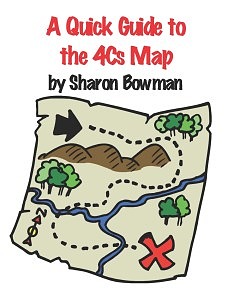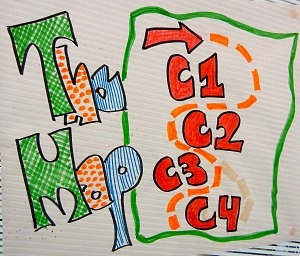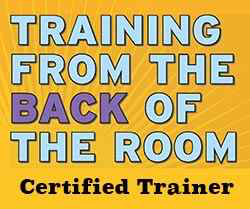A Quick Guide to the 4Cs Map (reposted)

The question keeps popping up: “What is an effective training design/delivery model that is easy to use and that enhances learning and retention?” My answer is the 4Cs Map. So I’m reposting: “A Quick Guide to the 4Cs Map.”
You have a choice to make right now: You can first view the slide presentation below, or you can scroll down to read the overview and description of the 4Cs Map first, before you view the slide presentation. The choice is yours …
How to Map Your Instruction in 4 Simple Steps
OVERVIEW: In a nutshell, the 4Cs Map is a 4-step instructional design and delivery model that is based on how human beings naturally and normally learn, NOT on outmoded assumptions about human learning.
Your brain is hardwired to learn in certain basic ways, regardless of age, gender, nationality, or culture. Here is an excellent summary of the hardwiring:
C1 – CONNECTIONS: The desire to learn – that is, to connect in meaningful ways to the physical environment and everything in it – is innate to the human brain.
For you personally, this means that, in order to learn effectively, you’ll want to connect your own past experiences and prior knowledge to the topic you’re learning about. The topic will need to be meaningful to YOU, not just to the person teaching it. And you’ll want to connect with anyone who can help you learn more about the topic – not just the “teacher,” but others who might have more knowledge or experience than you do.
All this applies to the people you teach, as well.
C2 – CONCEPTS: As your brain immerses itself in learning, it gathers information in all sorts of ways: watching, listening, doing, trial and error, until, over time, it creates mental and physical patterns that will translate into cognition, emotion, and physical action.
For you, this means you’ll try to fit any new information into the cognitive, emotional, and physical world you already know. There will be a struggle inside your brain until you can find that fit between what you already know and what you’re learning about.
The same applies to those you teach.
C3 – CONCRETE PRACTICE: This step goes hand-in-hand with the one before it. As the brain learns new information, it immediately begins the trial-and-error application of that information to the physical world.
For you, this means that you’ll want time to practice using the information you’ve learned. You’ll learn as much from your mistakes as you will from your successes. Gradually, you’ll master what you’ve learned – and, of course, one of the best ways to master anything is to teach it to someone else.
The people you instruct will need to do the same: to practice using the new information and to master it by teaching it to others.
C4 – CONCLUSIONS: Throughout the entire learning process, the brain assesses what it has learned and how it can use the new learning in its own life. The new learning gets folded into the old, and new cognitive, emotional, and physical patterns emerge.
For you, this means that you’ll do some self-reflection during this step of the learning process: evaluating what you’ve learned, how you can use it, how it will change your life, and how you feel about the entire learning experience up to now. Your feelings will also determine if you want to continue formally learning more about this topic.
This self-reflection step is also important to those you teach.
Once you understand how your own brain is hardwired to learn, it is easy to use this information to instruct others. You’ll begin to engage learners in your class or training in various ways throughout the entire learning experience:
 C1 – Connections: You’ll encourage learners to create meaningful connections of their own by discussing what they already know about the topic, what they want to learn, and by connecting with the other learners in meaningful ways.
C1 – Connections: You’ll encourage learners to create meaningful connections of their own by discussing what they already know about the topic, what they want to learn, and by connecting with the other learners in meaningful ways.
C2 – Concepts: You’ll have learners take in new information in multi-sensory ways: listening, seeing, talking, writing, drawing, choosing, reflecting, asking and answering questions, to name a few.
C3 – Concrete Practice: You’ll have learners practice using their new knowledge and teaching it to others through games, teach-backs, simulations, demonstrations, and learner-presentations.
C4 – Conclusions: You’ll give learners time for self-reflection, action-planning, and a celebration of some sort to have them feel a sense of satisfaction about what they’ve learned.
 The 4Cs Map is a simple way to make sure you include all four brain-based steps in every lesson, class, or training you create. I call it a “map” because maps help us get to where we want to go. They show us where we began, where we are, and where we’ll end up. “Using a map” is a great metaphor for this 4-step instructional design and delivery model.
The 4Cs Map is a simple way to make sure you include all four brain-based steps in every lesson, class, or training you create. I call it a “map” because maps help us get to where we want to go. They show us where we began, where we are, and where we’ll end up. “Using a map” is a great metaphor for this 4-step instructional design and delivery model.
When you’re comfortable using all four steps to design and deliver effective instruction, you can “mess with the map” and mix up the pieces in ways that serve your learners best. You can also create “mini-maps,” that is, breaking up large instructional components/modules into smaller “mapped” segments of instruction. The 4Cs Map is an eminently flexible and versatile design/delivery tool.
If you’ve never used the 4Cs Map (or if you want a refresher), here are some great resources to get you started:
Sharon’s Micro-Courses View the slide presentation in this blog. Then click on the Micro-Courses link, scroll down that page, and view: “Teaching Adults Anything in 4 Easy Steps.”
Sharon’s Articles Click on the Articles link, scroll down, and read the article titled: “Bag It! A Quick and Easy Way to Design Training.”
Training from the BACK of the Room! This is my definitive book about brain-based instruction and the 4Cs Map, with detailed explanations and activities for each step of this well-researched instructional design and delivery model. The book also lists all the resources for this brain-based instructional design and delivery model. The companion book to this one is: The Ten-Minute Trainer: 150 Ways to Teach It Quick and Make It Stick.
Finally, be sure to click on the red button below for your own free, downloadable guide to the 4Cs Map:
*********************
If you really really like knowing the “cognitive neuroscience” behind brain-based presenting and training, consider attending my 2-day “Training from the BACK of the Room” class – the only public TBR class that I will be facilitating for Spring/Summer 2018. The class will be held in Minneapolis MN on April 12th – 13th 2018. Click HERE for details and registration information (there are still seats left). Click HERE for a calendar of all TBR classes for 2017 – 2018 (classes are being added monthly so check back).
 I will also be facilitating the 1-day Trainer Certification Course following the 2-day TBR class in Minneapolis. This 1-day Trainer Certification Course will give you everything you need to be able to present the “official” 2-day TBR class for your own clients, customers, companies, and educational institutions. (Note: You must have attended a 2-day TBR class in order to attend the 1-day Trainer Certification Course.)
I will also be facilitating the 1-day Trainer Certification Course following the 2-day TBR class in Minneapolis. This 1-day Trainer Certification Course will give you everything you need to be able to present the “official” 2-day TBR class for your own clients, customers, companies, and educational institutions. (Note: You must have attended a 2-day TBR class in order to attend the 1-day Trainer Certification Course.)
As of now, the dates for the April 2018 Trainer Certification Course are sold out. However, there is a wait-list and, if enough people are interested, the sponsoring company (The Braintrust Consulting Group) may open up another Cert Course day. We should know by the end of December 2017 whether we have enough interested people to consider doing this.
Click HERE for more information and registration/sign-up for the wait-list for the April 2018 Trainer Certification Course.
Don’t forget to check out the free give-aways on my website’s “What’s New?” page while you’re here 🙂 And please pass this information along to anyone who is interested in exciting, unforgettable, learner-centered, brain-based instruction.